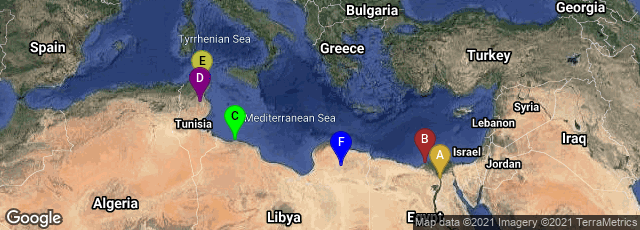One of the most dramatic movements of any people in history was the Arab conquest of North Africa in the seventh century. When Muhammad died in 632 CE only the western half of Arabia was Muslim; two years later the entire peninsula was brought to the faith, and Muslim armies moved into the desert between Syria and Mesopotamia. In 634 the Muslim leader
Umar (Omar) ascended to the role of
caliph and inherited a heterogeneous and rapidly expanding Islamic empire. Throughout the early 640s, he set his sights on the economically desirable province of Egypt and its capital city of Alexandria. The Muslim invasion of Egypt was led by the commander
Amr ibn Al-Aas, who commanded a force larger than any army the Byzantines could raise at the time after their crushing defeat at
Yarmuk four years earlier.
The Arab conquest of Egypt and North Africa began with the arrival of an army in 640 in front of the Byzantine fortified town of Babylon (in the area which is now Old Cairo). The Arabs captured it after a siege and established their own garrison town just to the east, calling it
Al Fustat. This became the capital of Egypt under Muslim conquest.
"Following Muslim conquest, the local populace and political infrastructure was left largely intact, albeit under Muslim control. Some groups were persecuted, namely anyone deemed to be "pagan" or an "idolater". The Muslim people were tolerant of the Jews and Christians of captured regions. Many rose to positions of relative power and affluence in the new cities like Baghdad.[3] This led to a stable and smooth running empire. The only major difference in treatment between Muslims and non-Muslims was the taxation system. Non believers were obligated to pay to the local government, called the jizya, while Muslims had to pay a Zakāt. Due to paying jizya by the non-believers, it becomes the mandatory responsibility to the Muslim ruler to protect their (non-believers) life and wealth. This jizya also as for the non-believers, who do not participate the war conducted by the Muslim government. jizya is not applicable for old persons, women and children only for the capable persons who are able to participate in war willingly not want to do so" (Wikipedia article Seige of Alexandria, accessed 9-2020).
In 1641 the Arab army then moved on to Alexandria, but there the
defences were sufficient to keep them at bay for fourteen months. At the end of that time a surprising treaty was signed; the Greeks of Alexandria agreed to leave peacefully. The Arabs gave them a year in which to depart. In the autumn of 642 Byzantium lost one of their richest provinces to the Arabs without a fight.
The Arabs continued to campaign westwards along the coast of North Africa, capturing
Cyrenaica in 642 and Tripoli in 643. But these remained largely ineffective outposts. For nearly three decades the Arabs made little progress in subduing the indigenous Berber inhabitants of this coastal strip.
The turning point of Arab conquest of North Africa occurred in 670 with the founding of a new Arab garrison town at
Kairouan, about sixty miles south of the Byzantine city of
Carthage. From this secure base military control became possible. The Arabs destroyed Carthage again in 698. By the early 8th century northwest Africa was firmly in Arab hands. In 711 an Arab general took the next expansionist step; with a
Berber army he crossed the straits of Gibraltar and entered Spain.
